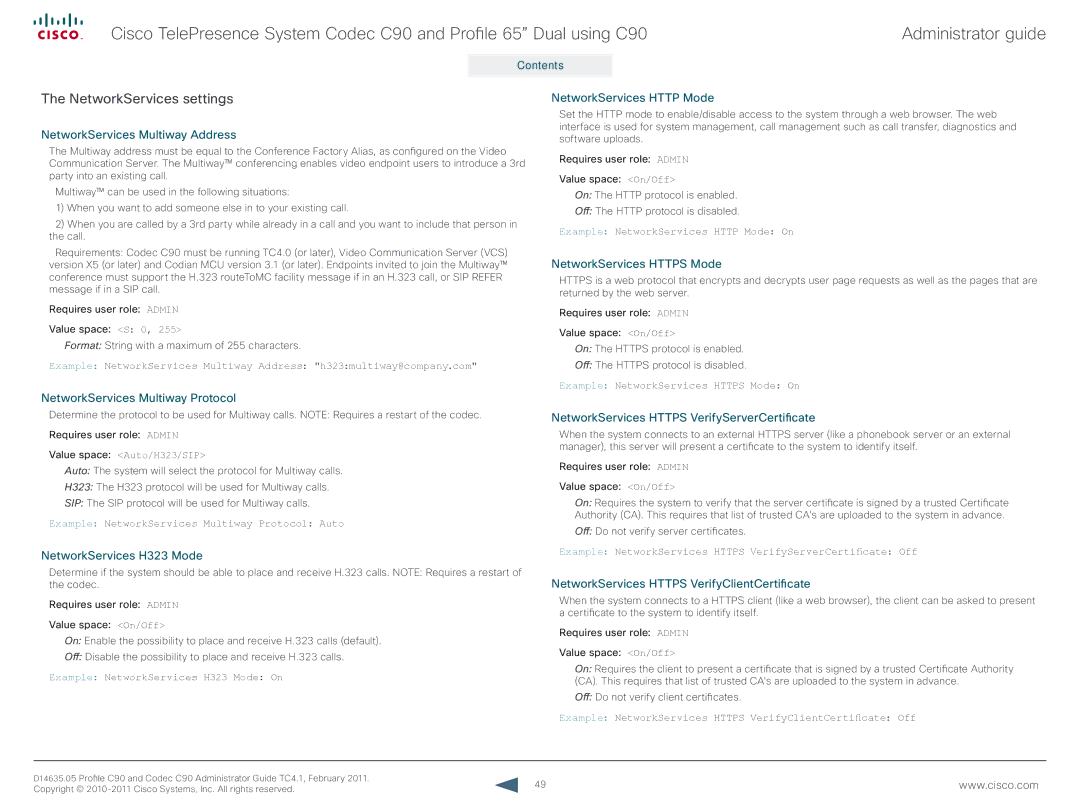
Cisco TelePresence System Codec C90 and Profile 65” Dual using C90 | Administrator guide |
Contents
Introduction
Web interface
Advanced configuration
Password protection
Appendices
Contact us
The NetworkServices settings
NetworkServices Multiway Address
The Multiway address must be equal to the Conference Factory Alias, as configured on the Video Communication Server. The Multiway™ conferencing enables video endpoint users to introduce a 3rd party into an existing call.
Multiway™ can be used in the following situations:
1)When you want to add someone else in to your existing call.
2)When you are called by a 3rd party while already in a call and you want to include that person in the call.
Requirements: Codec C90 must be running TC4.0 (or later), Video Communication Server (VCS) version X5 (or later) and Codian MCU version 3.1 (or later). Endpoints invited to join the Multiway™ conference must support the H.323 routeToMC facility message if in an H.323 call, or SIP REFER message if in a SIP call.
Requires user role: ADMIN
Value space: <S: 0, 255>
Format: String with a maximum of 255 characters.
Example: NetworkServices Multiway Address: "h323:multiway@company.com"
NetworkServices Multiway Protocol
NetworkServices HTTP Mode
Set the HTTP mode to enable/disable access to the system through a web browser. The web interface is used for system management, call management such as call transfer, diagnostics and software uploads.
Requires user role: ADMIN
Value space: <On/Off>
On: The HTTP protocol is enabled.
Off:The HTTP protocol is disabled.
Example: NetworkServices HTTP Mode: On
NetworkServices HTTPS Mode
HTTPS is a web protocol that encrypts and decrypts user page requests as well as the pages that are returned by the web server.
Requires user role: ADMIN
Value space: <On/Off>
On: The HTTPS protocol is enabled.
Off:The HTTPS protocol is disabled.
Example: NetworkServices HTTPS Mode: On
Determine the protocol to be used for Multiway calls. NOTE: Requires a restart of the codec.
Requires user role: ADMIN
Value space: <Auto/H323/SIP>
Auto: The system will select the protocol for Multiway calls.
H323: The H323 protocol will be used for Multiway calls.
SIP: The SIP protocol will be used for Multiway calls.
Example: NetworkServices Multiway Protocol: Auto
NetworkServices H323 Mode
Determine if the system should be able to place and receive H.323 calls. NOTE: Requires a restart of the codec.
Requires user role: ADMIN
Value space: <On/Off>
On: Enable the possibility to place and receive H.323 calls (default).
Off:Disable the possibility to place and receive H.323 calls.
Example: NetworkServices H323 Mode: On
NetworkServices HTTPS VerifyServerCertificate
When the system connects to an external HTTPS server (like a phonebook server or an external manager), this server will present a certificate to the system to identify itself.
Requires user role: ADMIN
Value space: <On/Off>
On: Requires the system to verify that the server certificate is signed by a trusted Certificate Authority (CA). This requires that list of trusted CA's are uploaded to the system in advance.
Off:Do not verify server certificates.
Example: NetworkServices HTTPS VerifyServerCertificate: Off
NetworkServices HTTPS VerifyClientCertificate
When the system connects to a HTTPS client (like a web browser), the client can be asked to present a certificate to the system to identify itself.
Requires user role: ADMIN
Value space: <On/Off>
On: Requires the client to present a certificate that is signed by a trusted Certificate Authority (CA). This requires that list of trusted CA's are uploaded to the system in advance.
Off:Do not verify client certificates.
Example: NetworkServices HTTPS VerifyClientCertificate: Off
D14635.05 Profile C90 and Codec C90 Administrator Guide TC4.1, February 2011. | 49 | www.cisco.com |
Copyright © |
